
I have to admit, the title of this article is a little misleading. Based on the title alone (and forgetting that you’re reading “Asphalt” not “Money”), many of you would have expected an article on how you could get your retirement savings to rebound in tough economic times.
But in the asphalt industry, recycled materials can have significant economic value to the contractor. As the amount of recycled material continues to increase in asphalt mixtures, it becomes even more important to understand how it can be blended with virgin materials to produce a mixture that will perform successfully in service. Proper asset (the recycled asphalt binder) recovery in the laboratory is a key first step.
Procedures for determining asphalt binder content in a mixture have largely progressed from solvent extraction to ignition oven procedures since the end of the Strategic Highway Research Program. However, the solvent extraction procedure is still needed as a first step in the process to recover the aged asphalt binder and determine its physical properties.
First, a sample of the asphalt mixture, pavement core, reclaimed asphalt pavement (RAP), or reclaimed asphalt shingles (RAS) is taken and heated for a brief time at 110º C (230º F) to ensure that any moisture is removed. Then the sample is weighed and the extraction/recovery procedure is started. There are a number of options for the extraction/recovery procedure, but the Asphalt Institute typically uses one of two methods:
- AASHTO T319 (ASTM D6847); or
- AASHTO T164 (ASTM D2172) in combination with ASTM D5404.
The AASHTO T319 procedure was developed during the Strategic Highway Research Program at Texas A&M University and later modified by the Purdue University/Asphalt Institute research team for the National Cooperative Highway Research Program project on RAP (NCHRP Project 9-12). It is an all-in-one procedure that extracts the asphalt binder from a sample, removes aggregate fines and proceeds to a recovery using a modified Rotavapor recovery procedure.
The advantage to this method is that it induces less solvent hardening of the recovered asphalt binder—meaning that the physical properties of the asphalt binder are not as negatively impacted by exposure to chemical solvents as in other procedures. The disadvantage of this method is that a smaller mixture sample size must be used—meaning that the amount of recovered asphalt binder is less than in other procedures. This could be an issue depending on the types of tests that will be performed on the recovered asphalt binder.
The AASHTO T164 procedure has been in use for many years and provides options for Centrifuge extraction (Method A), Reflux extraction (Method B) and other procedures. It is the extraction procedure with which the industry is most familiar. The advantage of using AASHTO T164 instead of T319 lies in the fact that a greater sample size can be used—meaning more asphalt binder can be recovered for testing using the Rotavapor recovery procedure (ASTM D5404). The disadvantage is that the greater sample size can lead to an increase in solvent hardening effects ? meaning the recovered asphalt binder may appear to be stiffer than it actually is.
Once the procedure has been completed, the recovered asphalt binder is drained from the recovery flask into a tin and is ready for testing to determine physical properties—a subject which will be discussed in the next “Lab Corner.”














